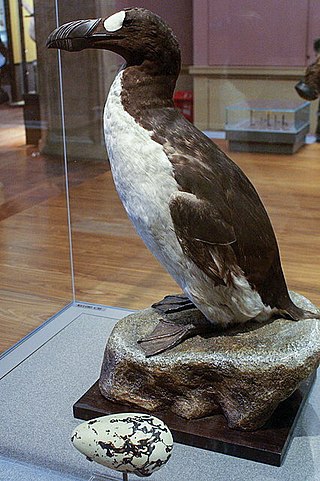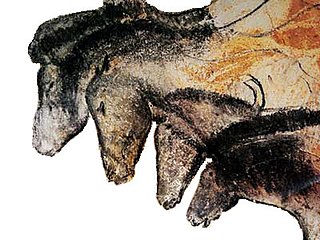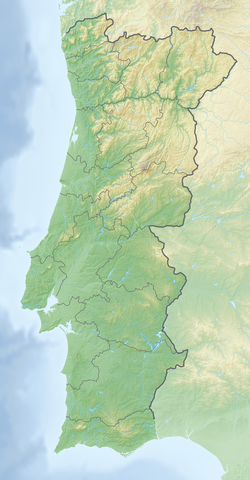
The great auk is a species of flightless alcid that became extinct in the mid-19th century. It was the only modern species in the genus Pinguinus. It is not closely related to the Southern Hemisphere birds now known as penguins, which were discovered later by Europeans and so named by sailors because of their physical resemblance to the great auk, which were called penguins.

Peniche is a seaside municipality and a city in the Oeste region, in the historical province of Estremadura, and in the Leiria District. It has 26,431 inhabitants, in an area of 77.55 km2. The city itself has a population of about 15,600 inhabitants. The present mayor is Henrique Bertino, elected by the independent coalition GCEPP.

The Chauvet-Pont-d'Arc Cave in the Ardèche department of southeastern France is a cave that contains some of the best-preserved figurative cave paintings in the world, as well as other evidence of Upper Paleolithic life. It is located near the commune of Vallon-Pont-d'Arc on a limestone cliff above the former bed of the river Ardèche, in the Gorges de l'Ardèche.
The Châtelperronian is a proposed industry of the Upper Palaeolithic, the existence of which is debated. It represents both the only Upper Palaeolithic industry made by Neanderthals and the earliest Upper Palaeolithic industry in central and southwestern France, as well as in northern Spain. It derives its name from Châtelperron, the French village closest to the type site, the cave La Grotte des Fées.

Torres Novas is a Portuguese municipality in the district of Santarém, in the Médio Tejo of the Centro region. The population of the municipality was approximately 36,717, in an area that encompasses 270 square kilometres (100 sq mi). The city of Torres Novas proper has about 15,000 inhabitants in an area located within the municipality.

Gorham's Cave is a sea-level cave in the British overseas territory of Gibraltar. Though not a sea cave, it is often mistaken for one. Considered to be one of the last known habitations of the Neanderthals in Europe, the cave gives its name to the Gorham's Cave complex, which is a combination of four distinct caves of such importance that they are combined into a UNESCO World Heritage Site, the only one in Gibraltar. The three other caves are Vanguard Cave, Hyaena Cave, and Bennett's Cave.

The Prehistoric Rock-Art Site of Escoural Cave is a structure known for its Paleolithic-era rock-art and funerary burial site, located in the Portuguese municipality of Montemor-o-Novo, in the civil parish of Santiago do Escoural.
Lagar Velho 1, also known as the Lagar Velho boy or Lapedo child, is a complete prehistorical skeleton found in Portugal, believed to be a hybrid that had a Neanderthal parent and an anatomically modern human parent.

Neanderthals are an extinct group of archaic humans who lived in Eurasia until about 40,000 years ago. The type specimen, Neanderthal 1, was found in 1856 in the Neander Valley in present-day Germany.
Jan F. Simek is an American archaeologist and educator who was the interim president of the University of Tennessee system from 2009 to 2010.

The Noisetier Cave, owing its popular name to the Hazel trees that grow in front of its entrance, is located in a mountainside 145 m (476 ft) atop the Vallée d'Aure in the Ardengost commune, Hautes-Pyrénées department in the region Occitania, Southern France. During systematic excavations since 1992 Middle Paleolithic stone tools and artifacts attributed to the Neanderthal Mousterian culture were discovered among numerous faunal remains.

Le Regourdou is an archaeological site in the Dordogne department, France, on top of a hill just 800 m (2,600 ft) from the famous cave complex of Lascaux. At this now collapsed 35 m (115 ft) deep ancient karst cavity remarkably well preserved Neanderthal fossils were recovered, that might be skeletal remains of deliberate burials. According to the current excavation team at the site, the correct name of the location is "Regourdou". "Le Régourdou" is considered a misnomer and should be avoided.
Cueva Antón is a paleoanthropological and archeological site in the Region of Murcia of southeast Spain. The cave is located about 60 kilometers from the Mediterranean port city of Cartagena inland in the territory of the municipality of Mula. It was eroded by the Río Mula and served as a cave in the Middle Palaeolithic inhabited by Neanderthals. The cave became internationally known in 2010, after a shell at least 43,000 years old with adhering orange pigment was discovered there. The pigment found was interpreted as evidence that the shell was used "in an aesthetic and probably symbolic" way. The find from the Cueva Antón was published together with similar finds from the Cave of Los Aviones; they were named as the first such Neanderthal jewelry found in Europe. The colonization of the Iberian Peninsula by modern man took place only several thousand years after the creation of the jewelry from the Cueva Antón. This site is the last known place where Neanderthal people resided.

The Cave of Aroeira is an archaeological and paleoanthropological site in the Portuguese Estremadura Limestone Massif. The cave is located in the village of Almonda, in the civil parish of Zibreira, in the municipality of Torres Novas in the district of Santarém. The cave contained stones from the Paleolithic Acheulean culture, and the skull of Homo heidelbergensis, circa 400,000 years old. The discovery of Aroeira 3 was announced in spring 2017 - the earliest human trace in Portugal.

Aroeira 3 is a 400,000 year old Homo heidelbergensis hominid skull which was discovered in the Aroeira cave, Portugal. It is the earliest human trace in Portugal. H. heidelbergensis existed at the transition between Homo erectus and early Neanderthals and used both stone tools and fire. The skull was damaged during the 2014 excavation but was restored in the following two years. In 2017 the description of the skull was published in PNAS. It is on display in the National Archaeology Museum (Lisbon).

The Cave of Pego do Diabo is a small karst cave in a Turonian limestone outcrop located about 250 metres above sea level in the municipality of Loures, about 20 km north of Lisbon in Portugal. The erosion of the outcrop resulted in a set of openings in the rocks wide enough to be exploited by humans. Several archaeological studies have been conducted within the cave, which give insights into the duration of Neanderthal presence on the Iberian Peninsula and to the presence of carnivorous animals during the Paleolithic.

The Cave of Salemas is located close to the village of Lousa in the municipality of Loures in the Lisbon District of Portugal. Discovered by archaeologists during the 1950s, the cave appears to have been occupied by humans as a temporary refuge during the Upper Paleolithic and used as a tomb during the Neolithic.

Francesco d'Errico is an archaeologist who works as CNRS Director of Research at the University of Bordeaux in France and Professor at the Centre for Early Sapiens Behaviour, University of Bergen. In 2014 he was awarded the CNRS silver medal. In 2015 Giorgio Napolitano, president of Italy, presented him with the Fabio-Frassetto prize from the Accademia dei Lincei.

Paleolithic in the Iberian peninsula is the longest period of its prehistory, starting c. 1.3 million of years (Ma) ago and ending almost at the same time as Pleistocene, first epoch of Quaternary, c. 11.500 years or 11.5 ka ago. It was a period characterized by climate oscillations between ice ages and small interglacials, producing heavy changes in Iberia's orography. Cultural change within the period is usually described in terms of lithic industry evolution, as described by Grahame Clark.















